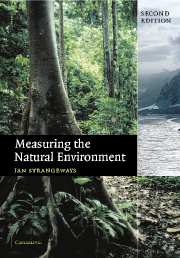Book contents
- Frontmatter
- Contents
- Acknowledgements
- 1 Basics
- 2 Radiation
- 3 Temperature
- 4 Humidity
- 5 Wind
- 6 Barometric pressure
- 7 Evaporation
- 8 Precipitation
- 9 Soil moisture and groundwater
- 10 Rivers and lakes
- 11 Data logging
- 12 Telemetry
- 13 Visibility
- 14 Clouds
- 15 Lightning
- 16 The upper atmosphere
- 17 The oceans
- 18 Cold regions
- 19 Remote sensing
- 20 Atmospheric composition
- 21 Forward look
- Appendix: abbreviations and acronyms
- Index
- References
15 - Lightning
Published online by Cambridge University Press: 05 July 2014
- Frontmatter
- Contents
- Acknowledgements
- 1 Basics
- 2 Radiation
- 3 Temperature
- 4 Humidity
- 5 Wind
- 6 Barometric pressure
- 7 Evaporation
- 8 Precipitation
- 9 Soil moisture and groundwater
- 10 Rivers and lakes
- 11 Data logging
- 12 Telemetry
- 13 Visibility
- 14 Clouds
- 15 Lightning
- 16 The upper atmosphere
- 17 The oceans
- 18 Cold regions
- 19 Remote sensing
- 20 Atmospheric composition
- 21 Forward look
- Appendix: abbreviations and acronyms
- Index
- References
Summary
On a second night we witnessed a splendid scene of natural fireworks; the mast-head and yard-arm ends shone with St. Elmo's light; and the form of the vane could almost be traced, as if it had been rubbed with phosphorus. The sea was so highly luminous, the tracks of the penguins were marked by a fiery wake, and lastly, the darkness of the sky was momentarily illuminated by the most vivid lightning.
Charles Darwin Voyage of the Beagle (on the sea journey from Rio to Montevideo).The variable and its history
Lightning was probably the cause of the first fires seen by humans, but before Benjamin Franklin performed his experiments with a kite, it was just a mysterious and terrifying natural phenomenon, although others had been debating the matter before this. Born in 1706, Franklin was one of those rare creative people who encompassed great areas of knowledge and action — as printer, moralist, essayist, civic leader, statesman, diplomat, philosopher and, of course, as scientist and inventor. He lived in Great Britain from 1757 to 1762 and was long opposed to the American colonies separating from the British Empire. But after the Boston Tea Party, and Britain's harsh response, his efforts were doomed and in 1775 he became convinced that ‘more mischief than benefit’ would come from closer union. He helped draft the Declaration of Independence, and signed it at the age of 70.
- Type
- Chapter
- Information
- Measuring the Natural Environment , pp. 361 - 382Publisher: Cambridge University PressPrint publication year: 2003



